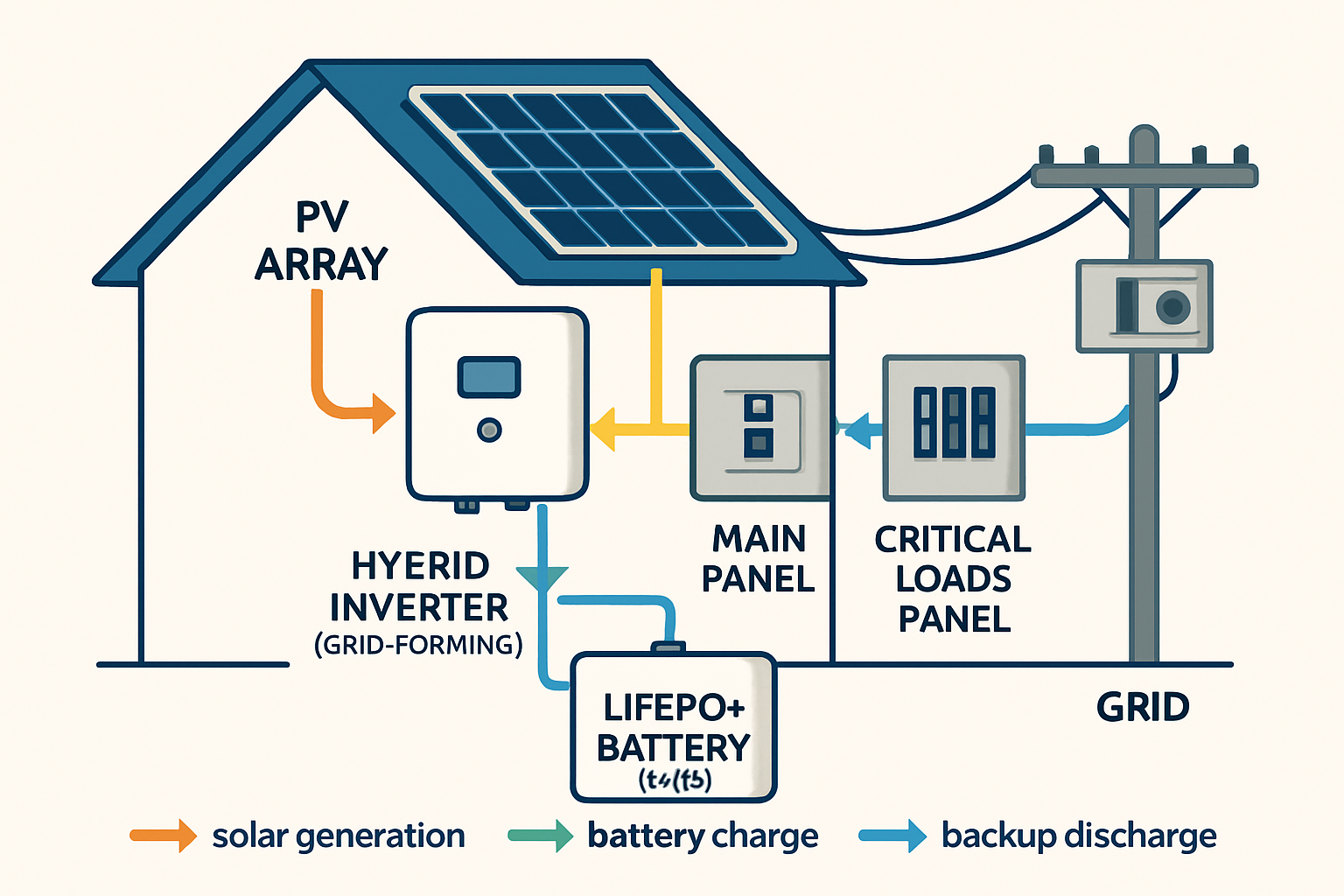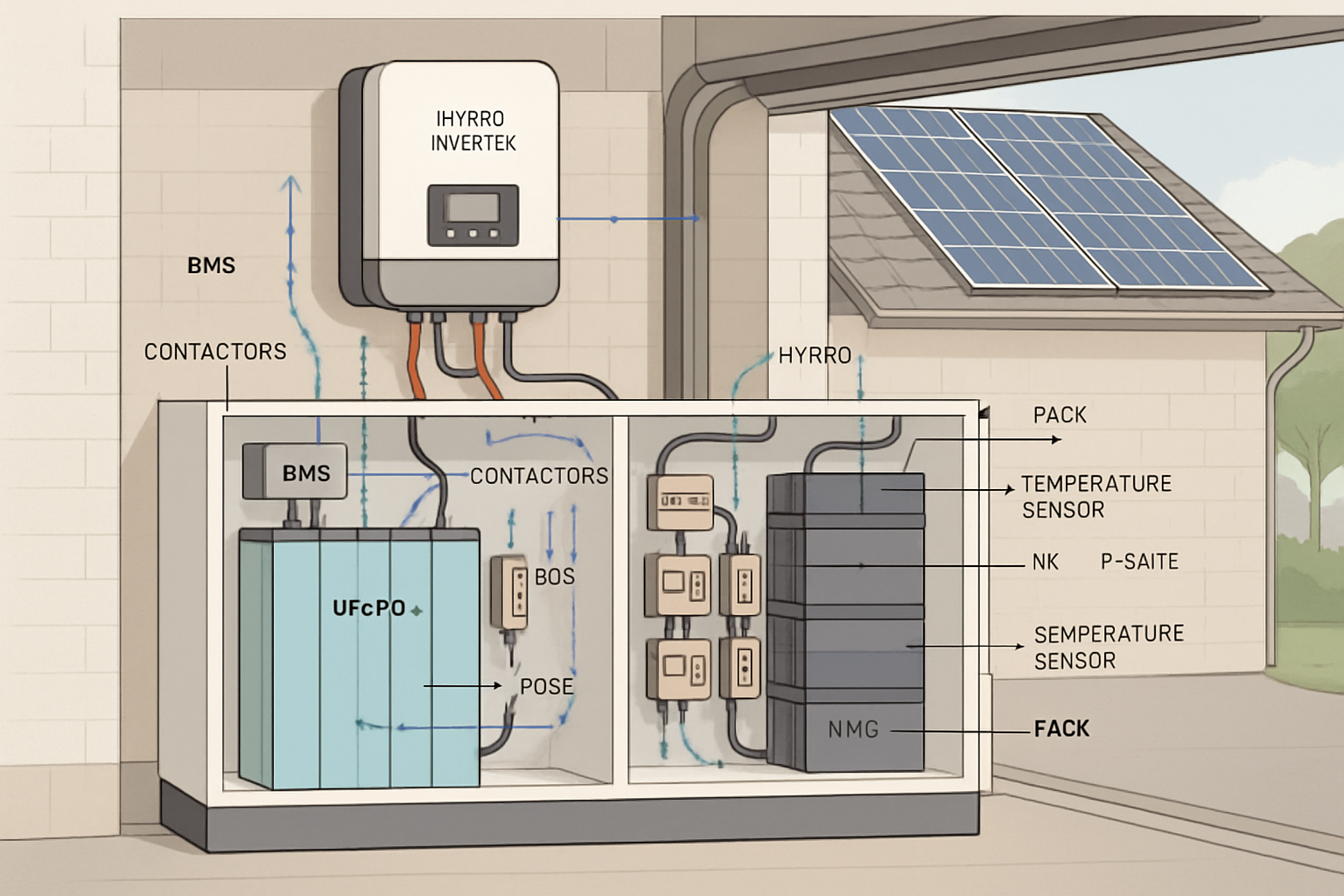Many farms want reliable power without grid constraints. Off-grid solar can deliver that, yet myths still slow projects. This case-led piece sets expectations with data, simple calculations, and field-proven practices. You will see how to size a system for pumps, cold rooms, fencing, and tools. You will also learn where storage fits, what it costs, and how to run a tidy, safe setup.

Farm energy profile and off-grid basics
Every successful off-grid solar design starts with the load. Farms often have a mix of steady and peaky uses. Examples include water pumping, refrigeration, ventilation, lighting, electric fencing, security, and workshop tools.
- Daily energy: kWh per day across seasons.
- Peak power: kW at any instant, plus motor starting surge.
- Duty cycles: irrigation hours, cooling cycles, and harvest peaks.
An off-grid solar system bundles four core parts: PV array, solar inverter (or hybrid inverter), battery storage, and optional generator. Lithium iron phosphate (LiFePO4) storage suits farm duty. It offers stable thermal behavior, long cycle life, and deep usable capacity. A modern ESS can integrate panels, inverter, and batteries into a compact unit for faster commissioning and simpler maintenance.
Myths vs reality: what farms really need
Myth 1: Off-grid solar cannot run large pumps
Reality: You can start and run pumps with correct inverter and motor controls. Size the inverter for both continuous power and surge. Many pumps draw 2–6 times their rated power at startup. Use a variable-frequency drive (VFD) or soft starter to cut surge and improve efficiency. Three-phase loads are possible with the right inverter or VFD setup.
The claim that weather-driven variability is “unmanageable” has been addressed at system level in independent reviews. As noted in Getting Wind and Solar onto the Grid, variability can be handled with the right tools. On a farm, those tools are smart controls, adequate inverter headroom, and aligned pumping schedules.
Myth 2: Storage always costs too much and wears out fast
Reality: LiFePO4 costs have trended down and cycle life is strong. Utility-scale data show rapid growth and cost improvements in batteries over recent years. The U.S. Energy Information Administration notes expanding capacity and falling installed costs per kW for battery storage projects in Battery Storage Market Trends. Global tracking from IRENA also documents declining renewable and storage costs and improved value in many applications; see IRENA’s Costs portal.
For farm duty, a LiFePO4 pack designed for daily cycling can run thousands of cycles under moderate depth-of-discharge. That translates to many years of use with good thermal management and proper charge profiles.
Myth 3: Off-grid solar requires a 1:1 backup generator
Reality: Auxiliary generation helps in long storms or during unusual peaks, but a strict 1:1 rule wastes capital. A better plan is to size PV and storage to cover typical days and use a generator as an infrequent safety net. At the grid level, the claim that variable renewables need “one-for-one backup” is a misconception highlighted in Getting Wind and Solar onto the Grid. On a farm, flexible loads, larger PV in the wet season, and good scheduling cut generator hours. You can also throttle irrigation to sunny hours to push more energy direct from PV into pumps, limiting battery cycling.
Myth 4: Solar is too unreliable in cloudy seasons
Reality: Design for seasonal irradiance, tilt panels for winter sun if needed, and plan battery autonomy for your risk tolerance. The IEA has shown that integration challenges grow in steps and can be managed phase by phase; see Next Generation Wind and Solar Power. At farm scale, one to two days of usable storage plus a small generator often provides robust cover. Smart charge controllers and remote monitoring maintain stable operation during variable weather.
Myth 5: Off-grid systems are too complex to maintain
Reality: Integrated ESS hardware reduces wiring and commissioning steps. Technicians can learn quickly with hands-on training. A DOE success story shows students building a small off-grid array for tools in only a few days, which later supported community projects; see EERE Success Story—Oglala Lakota College gets Hands-On Training for Off-Grid Solar. Many farm systems now include remote diagnostics and alarms for preventive care.
Case study: mixed-crop farm off-grid design
Below is a practical, numbers-first snapshot for a small mixed-crop farm that wants reliable off-grid power for pumping, cooling, and daily operations.
Assumptions and daily loads (peak season)
- Irrigation pump: 5 kW, 4 h/day (VFD), surge factor 2.5x
- Cold room: 2 kW average, 12 h/day (24 kWh/day with cycling)
- Lighting, fencing, controls: 0.5 kW, 8 h/day
- Workshop/tools: 2 kW, 2 h/day (intermittent)
| Load | Power (kW) | Hours/day | Energy (kWh/day) |
|---|---|---|---|
| Irrigation pump | 5 | 4 | 20 |
| Cold room | 2 | 12 | 24 |
| Lighting & fencing | 0.5 | 8 | 4 |
| Workshop/tools | 2 | 2 | 4 |
| Total | — | — | 52 |
Proposed off-grid solar design
- PV array: 12 kWdc, tilted for seasonal output. With 5 peak sun hours on clear days, expected energy is about 60 kWh/day. Oversize 10–20% if haze or dust is common.
- Hybrid inverter: 10 kVA continuous, 2.5x surge for motor starts (with VFD). Three-phase available via dedicated drives if needed.
- LiFePO4 battery: 40 kWh nominal, 80% usable (≈32 kWh). That gives about 0.6 days of autonomy on peak days, and 1+ days on average days. Expandable racks allow growth as loads rise.
- Generator: 8–12 kW diesel or LPG as backup for multi-day storms or harvest peaks. Automatic start can protect cold storage.
- Controls: Prioritize pumping at midday to use direct PV. Shift non-critical tools to sunlit hours. Limit cold room defrost cycles to late morning.
This setup meets the 52 kWh/day profile in most bright conditions and leans on storage to carry evening and night loads. The generator may run a few hours during long cloudy spells, cutting fuel use sharply compared with full diesel.
Myths vs reality summary
| Myth | Reality | Design implication |
|---|---|---|
| “Solar can’t run pumps.” | It can, with surge-aware inverters and VFDs. | Size inverter for surge; add soft starts; schedule pumping at noon. |
| “Batteries cost too much and die fast.” | LiFePO4 prices have improved; cycle life is strong. | Use LiFePO4, moderate DoD, good thermal management. |
| “You need 1:1 generator backup.” | Right-sized PV and storage plus flexible loads reduce generator hours. | Keep a generator, but use it sparingly for edge cases. |
| “Clouds make systems unreliable.” | Seasonal design and modest autonomy keep service steady. | Adjust tilt, add autonomy days, and set load priorities. |
| “Maintenance is too complex.” | Integrated ESS simplifies install and upkeep. | Use hybrid inverters, remote monitoring, and clean wiring. |
Design checklist and sizing tips
1) Start with accurate loads
- List every device. Log hours and seasons. Note motor ratings and start current.
- For cold rooms, use real compressor duty cycles, not nameplate alone.
2) Size the inverter and wiring
- Continuous kW ≥ sum of likely simultaneous loads.
- Surge rating ≥ 2–3x motor kW for several seconds. VFDs help lower this.
- Use correct cable gauge to limit voltage drop. Keep runs short. Bond and ground properly.
3) Right-size LiFePO4 storage
- Usable kWh ≥ night loads + resilience margin. Many farms pick 1–2 days of autonomy.
- Target 70–90% round-trip efficiency with LiFePO4. Set charge voltages per maker specs.
4) Match PV to season
- Use local irradiance data. Add 10–20% headroom for dust, heat, and soiling.
- Tilt for winter if cold storage runs year-round. Trackers can help in some regions.
5) Controls and operations
- Shift flexible loads to sunny hours. Operate irrigation at midday.
- Use temperature setpoints and defrost timing to align cooling with PV output.
- Enable remote alarms for battery SOC, inverter temperature, and generator status.
What the data says
Independent research supports practical integration and smart planning. Key reads:
- Getting Wind and Solar onto the Grid clarifies common myths on variability, backup, grid costs, and storage needs, and frames integration as a staged process.
- System Integration of Renewables updates best practices, including tariff and planning reforms that value distributed resources.
- Next Generation Wind and Solar Power shifts focus from cost alone to system value, a helpful lens for farm scheduling and storage sizing.
- Battery Storage Market Trends tracks capacity additions and cost shifts that make storage more attainable.
- EERE Success Story—Oglala Lakota College gets Hands-On Training for Off-Grid Solar shows real users gaining skills fast and using off-grid systems for productive work.
- IRENA Renewable Costs provides global data trends that inform long-term planning and component choices.
Product notes and fit for farms
Agricultural sites benefit from robust lithium storage, integrated ESS, and clean AC power. LiFePO4 batteries handle deep cycling and heat better than many chemistries. A hybrid solar inverter converts DC to AC, manages battery charging, and coordinates generator input. An off-grid solar package for farms can include:
- LiFePO4 battery modules with scalable racks.
- Hybrid inverter with high surge capability and generator port.
- PV modules sized to seasonal demand and roof or ground constraints.
This stack aims for reliable, quiet power and lower fuel bills. The design also supports energy independence as loads grow. Start smaller and expand capacity in steps.
Key takeaways for farm owners
- Myths about pumps, storage, and reliability fade with correct sizing and controls.
- Right-size PV and LiFePO4 storage, then keep a modest generator for rare cases.
- Use VFDs for motors, midday scheduling for pumping, and remote monitoring for uptime.
- Track actual kWh. Adjust tilt, add strings, or extend storage as the farm scales.
- Lean on established data and staged integration practices from sources such as the IEA, EIA, IRENA, and the U.S. DOE.





Leave a comment
All comments are moderated before being published.
This site is protected by hCaptcha and the hCaptcha Privacy Policy and Terms of Service apply.